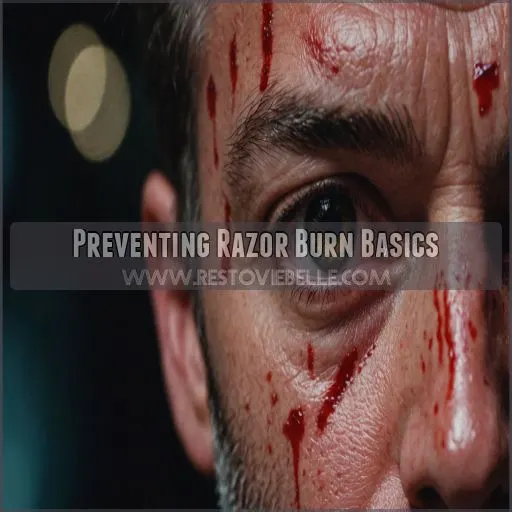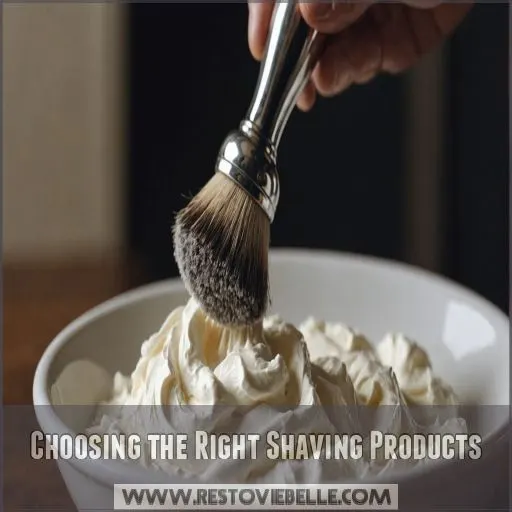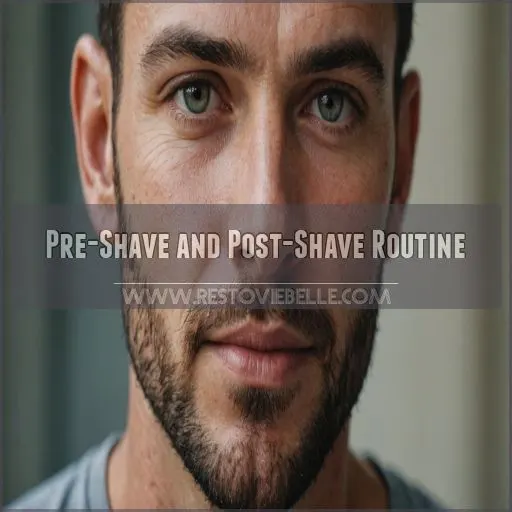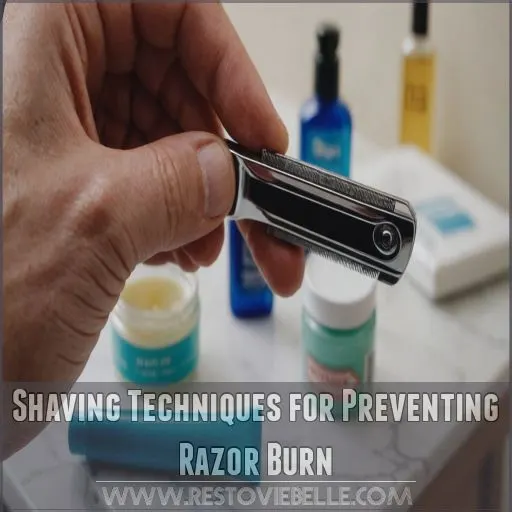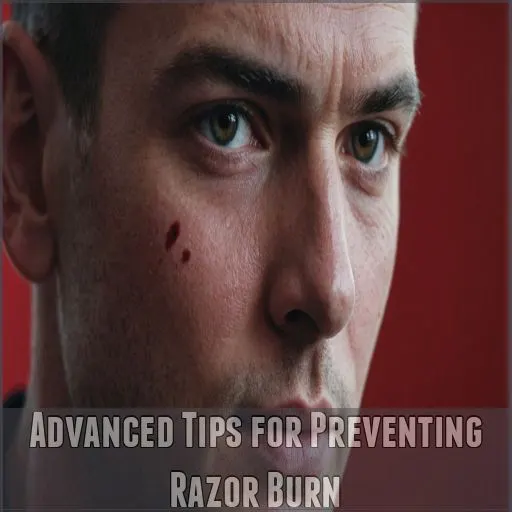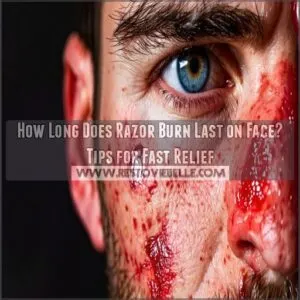This site is supported by our readers. We may earn a commission, at no cost to you, if you purchase through links.
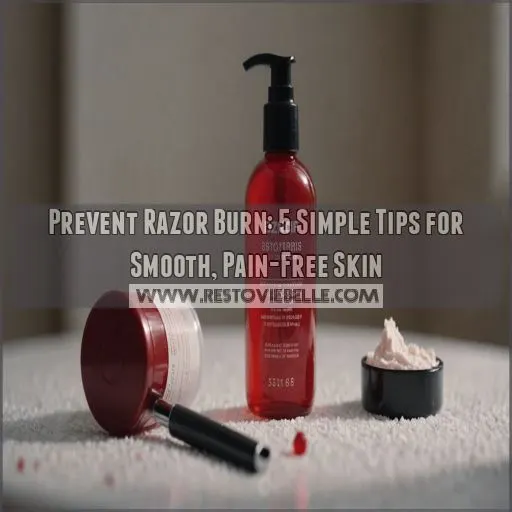
Always shave in the direction of hair growth using light, short strokes. Keep your razor clean and sharp – a dull blade is a one-way ticket to irritation city!
After shaving, rinse with cool water and apply a soothing, fragrance-free moisturizer.
Don’t forget to exfoliate regularly to prevent those pesky ingrown hairs. It’s like giving your skin a spa day every time you shave!
Remember, your skin is unique, so finding the perfect routine might take some trial and error. But trust us, your smooth, burn-free skin is worth it, and it’s all about taking the time to get it right and being gentle with your skin.
Table Of Contents
- Key Takeaways
- Preventing Razor Burn Basics
- Choosing the Right Shaving Products
- Pre-Shave and Post-Shave Routine
- Top 5 Products to Prevent Razor Burn
- Shaving Techniques for Preventing Razor Burn
- Advanced Tips for Preventing Razor Burn
- Frequently Asked Questions (FAQs)
- Can ice help a razor burn?
- How to prevent razor burn?
- What are the best at-home remedies for Razor Burn?
- How do you get rid of Razor Burn After shaving?
- How do you stop razor burn from forming?
- Why am I so prone to razor burn?
- What helps prevent razor burn down there?
- How do you stop razor cuts from burning?
- How does skin type affect razor burn risk?
- Can certain medications increase razor burn susceptibility?
- Is razor burn more common in specific body areas?
- How long does it typically take for razor burn to heal?
- Are there genetic factors that influence razor burn occurrence?
- Conclusion
Key Takeaways
- Prep like a pro: Before you take your razor on a joyride, soften your skin and hair with warm water. It’s like giving your skin a spa day before the main event. Don’t forget to exfoliate gently to kick those dead skin cells to the curb.
- Choose your weapons wisely: A sharp, clean razor is your best friend in the battle against razor burn. Pair it with a soothing shaving cream or gel, and you’re setting yourself up for silky-smooth success. Remember, a dull blade is about as useful as a chocolate teapot.
- Shave smart, not hard: Go with the flow and shave in the direction of hair growth, using light, short strokes. It’s not a race, folks. Take your time and rinse your razor frequently to avoid clogging. Think of it as giving your skin a gentle massage rather than mowing the lawn.
- Treat your skin like royalty post-shave: After you’ve conquered the shave, cool things down with a splash of cold water. Then, pamper your skin with a soothing, fragrance-free moisturizer. It’s like tucking your skin in for a cozy nap – comfortable, protected, and ready to face the world.
Preventing Razor Burn Basics
Razor burn can be a real pain, but don’t worry – we’ve got your back.
Understanding the causes and your skin type is key to preventing those pesky red bumps and irritation.
Understanding the Causes of Razor Burn
When tackling razor burn, it’s often due to dry shaving or using dull blades, which can irritate sensitive skin.
The wrong shaving technique might lead to trouble, and don’t forget that stubborn hair growth could turn into ingrown hairs, resulting in pseudofolliculitis barbae.
- Dry shaving without lubrication
- Dull or clogged blades
- Wrong shaving technique
Identifying Your Skin Type and Sensitivity
Razor burn often stems from mismatched shaving techniques, so knowing your skin type—dry, oily, or sensitive—can save you grief.
Take a skin type quiz to pinpoint your needs.
This knowledge helps you craft a personalized skincare routine with product recommendations to build a healthy skin barrier. Remember, caring for your skin is like nurturing a plant: give it what it needs.
Shaving Techniques to Avoid Razor Burn
Use a sharp razor blade for smooth, fearless shaving. Gently apply shaving gel with a brush, like painting a masterpiece.
Wet shaves beat dry shaves just like comfort beats mingling at awkward parties.
Shave with the hair’s flow, using short strokes to dodge razor burn and ingrown hairs.
Post-shave, soothe your skin with cool care.
Choosing the Right Shaving Products
Picking the right shaving products is like choosing the perfect coffee mug—it just makes everything better.
Stick with sensitive skin products, such as sensitive skin creams, to keep your grooming routine smooth and hassle-free
.
Shaving Creams and Gels for Sensitive Skin
After understanding razor burn basics, let’s prevent it with the right shaving creams and gels. Choose fragrance-free and natural options to soothe your sensitive skin.
Consider these tips:
- Look for products with colloidal oatmeal for calming effects.
- Pick trusted brands like Proraso or TOBS designed for sensitive skin.
- Experiment with DIY recipes if you’re adventurous.
Natural Ingredients for Soothing Razor Burn
Imagine this: your skin feels like a cactus after shaving; that’s where nature steps in!
Aloe vera soothes like grandma’s warm hugs, while witch hazel and tea tree oil work tirelessly to calm those fiery bumps.
Coconut oil hydrates, and an oatmeal bath adds a sprinkle of magic.
If things persist, check with your healthcare provider—better safe than sorry with a healthcare provider. .
Pre-Shave and Post-Shave Routine
Preparing your skin before and after shaving is key to preventing razor burn, especially when dealing with acne-prone skin conditions like ingrown hairs and clogged pores found in shaving and acne
.
Start by soaking in warm water to soften hair.
Then apply a soothing, moisturizing balm after to calm any irritation.
Pre-Shave Skincare Routine to Prevent Razor Burn
Start your pre-shave routine with some warm water to open up those pores.
Exfoliation is your secret weapon—clear away dead skin so your razor glides like a pro.
Don’t skip the pre-shave oils; they’re like a superhero cape for your skin, boosting hydration and protection.
Remember, proper skin prep is where control meets safety, ensuring smooth, rash-free shaving.
Cold Compresses and Aloe Vera for Reducing Inflammation
Imagine your skin sighing with relief as you apply a cold compress before shaving. This cooling method reduces inflammation and prepares your skin for a smooth shave, just like using a magic shave powder paste before shaving
.
Afterwards, pamper yourself with aloe vera. It offers natural remedies for skin irritation and boasts remarkable benefits in soothing razor burn. Who knew shaving could be this enjoyable?
Top 5 Products to Prevent Razor Burn
When razor burn hits, your skin can feel like it’s gone through a rough patch, quite literally.
To keep those red bumps at bay, and your shaving experience as smooth as possible, here’s a rundown of the top products you’ll want in your arsenal.
1. La Roche Posay Cicaplast Balm B5
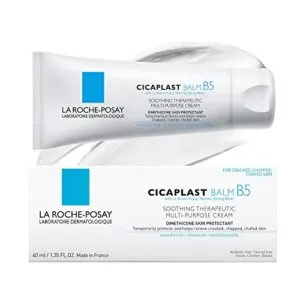
La Roche Posay Cicaplast Balm B5 is your go-to for soothing razor burn.
This versatile balm hydrates and calms irritated skin, making it a lifesaver for post-shave care. Packed with vitamin B5 and shea butter, it helps repair and strengthen your skin barrier, reducing redness and inflammation.
Even if you’ve had a rough shave, think of this balm as your peace treaty with your skin. It’s suitable for everyone, from babies to adults, and keeps skin soft without any greasy leftovers, making it a great option for soothing razor burn .
Best For: La Roche-Posay Cicaplast Balm B5 is best for those with sensitive skin who experience dryness, irritation, or razor burn.
- Soothes and hydrates irritated skin.
- Helps repair and strengthen the skin barrier.
- Suitable for all ages, including babies.
- May be too thick for some skin types.
- Can be expensive compared to other similar products.
- Not specifically designed for acne-prone skin.
2. Shea Butter Sensitive Shaving Cream
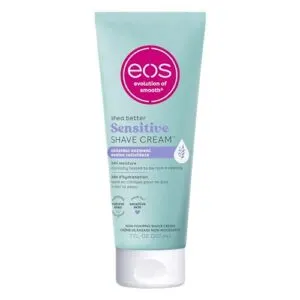
A trusty companion in your shaving routine, Shea Butter Sensitive Shaving Cream offers a close shave while pampering sensitive skin, ideal for those seeking gentle shaving solutions
.
Packed with soothing shea butter, it prevents razor burn and nicks, leaving your skin feeling velvety smooth.
With its fragrance-free, 24-hour hydration formula, you can kiss irritation goodbye and say hello to comfort and freedom every time you shave.
Plus, it’s vegan and cruelty-free, aligning with your values.
Talk about having your cake and shaving it too!
Best For: This shaving cream is best for people with sensitive skin who want a close shave without irritation, especially when using a best razor for black men
.
- Provides a smooth, close shave without drying skin.
- Helps prevent razor burn and nicks.
- Vegan and cruelty-free.
- Some users found the cream to be thick and clog razors.
- Some users found the scent to be strong.
- Some users found the product to be expensive compared to other shaving gels.
3. Aquaphor Healing Ointment Skin Protectant
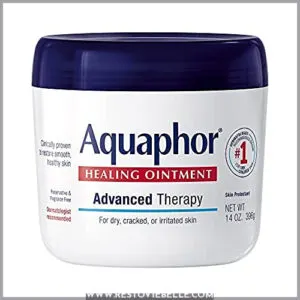
For those with sensitive skin, Aquaphor Healing Ointment is your secret weapon against razor burn.
This versatile product creates a protective barrier on your skin, allowing oxygen flow for the best healing . You’ll love how it keeps your skin hydrated and cooled post-shave.
While it might feel a bit greasy, don’t let that deter you – its effectiveness in treating skin irritation is worth it (Source).
Pro tip: Apply a thin layer before bed to wake up with soothed, smooth skin. Remember, a little goes a long way with this powerhouse product.
Best For: Those with sensitive skin prone to razor burn or other skin irritations.
- Creates a protective barrier that allows for oxygen flow to help heal skin.
- Keeps skin hydrated and cooled post-shave.
- Effective in treating skin irritation.
- Can be greasy.
- May transfer to clothing.
- May not be suitable for use during the daytime.
4. CeraVe Moisturizing Cream for Dry Skin
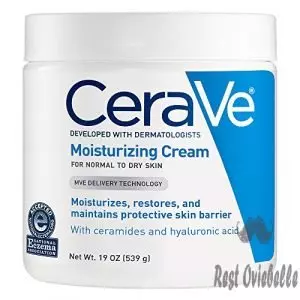
With CeraVe Moisturizing Cream, you’re not just treating razor burn – you’re fortifying your skin’s natural barrier.
This dermatologist-developed cream packs a powerful punch with three essential ceramides and hyaluronic acid, working tirelessly to hydrate and protect your skin for a full 24 hours.
Its non-comedogenic, fragrance-free formula is perfect for sensitive skin, whether you’re battling razor burn on your face, neck, or body.
The rich, velvety texture absorbs quickly without leaving you feeling greasy, making it an ideal post-shave moisturizer. Plus, it’s gentle enough for daily use, helping to prevent future razor burn woes.
Best For: CeraVe Moisturizing Cream is best for those with dry skin, including those suffering from razor burn or eczema.
- Formulated with ceramides and hyaluronic acid to hydrate and protect the skin’s natural barrier.
- Non-comedogenic, fragrance-free, and gentle, making it suitable for sensitive skin.
- Absorbs quickly without leaving a greasy residue, making it ideal for use as a post-shave moisturizer.
- Some users may find the texture too thick or heavy.
- While it’s effective for dry skin, it may not be moisturizing enough for extremely dry or dehydrated skin.
- The pump top packaging can be difficult to use when there’s only a little product left.
5. Tend Skin After Shave Solution
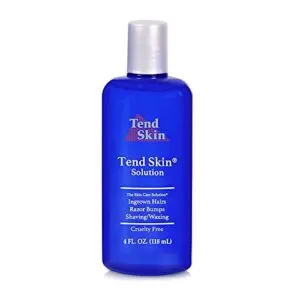
Tend Skin After Shave Solution is a powerful ally in your fight against razor burn. This USA-made product reduces redness after shaving but also tackles those pesky ingrown hairs and razor bumps.
You’ll love how quickly it dries, leaving your skin feeling refreshed. While it packs a punch with its strong smell, a little goes a long way.
Just remember to use it in a well-ventilated area and apply a thin coat after patting your skin dry. For stubborn ingrowns, try using it at night for extra effectiveness, especially for those stubborn ingrowns.
Best For: People with sensitive skin who struggle with razor bumps and ingrown hairs after shaving or waxing.
- Significant reduction in redness after one use
- Easy to use
- Dries quickly
- Strong smell
- Drying on skin
- Can cause peeling of sensitive skin
Shaving Techniques for Preventing Razor Burn
You’ve got the tools, but do you know the techniques? Mastering the right shaving methods can be the difference between silky-smooth skin and a painful, irritated mess.
Shaving in the Direction of Hair Growth
To tame the razor burn beast, you’ve got to go with the flow – literally.
Shaving in the direction of hair growth is your secret weapon against irritation . Picture your hair as tiny soldiers marching in formation; you want to gently coax them, not wage war.
This technique works wonders for all body parts, from your rugged jawline to your delicate bikini zone.
Remember, your hair type might throw you a curveball, so pay attention to those unique growth patterns, and always go with the flow – your secret weapon.
Using Short, Light Strokes for Smoother Shaving
When it comes down to preventing razor burn, mastering short, light strokes is your secret weapon. Think of your razor as a delicate paintbrush, not a lawnmower. To take your shaving technique to the next level, consider using a safety razor or a cartridge razor that allows you to adjust the blade angle.
- Minimizes skin irritation
- Reduces the risk of nicks and cuts
- Helps you get a closer, smoother shave
- Helps maintain proper blade angle
Remember, you’re not mowing the lawn – you’re crafting a masterpiece! Keep those strokes short and sweet for silky-smooth results.
Rinsing the Razor Frequently to Prevent Clogging
You’ve mastered light strokes, now let’s tackle razor clogging. Rinsing your blade frequently isn’t just good hygiene—it’s your secret weapon against razor burn.
A clean razor glides smoothly, reducing irritation and giving you a closer shave. Here’s why keeping your razor debris-free matters:
| Benefits | Drawbacks |
|---|---|
| Smoother shave | Takes more time |
| Reduced irritation | Uses more water |
| Longer-lasting blades | Requires attention |
| Cleaner results | Slows down process |
Remember, a clogged razor is like trying to cut grass with rusty scissors—ineffective and potentially painful.
Advanced Tips for Preventing Razor Burn
You’ve mastered the basics of preventing razor burn, but now it’s time to take your shaving game to the next level.
These advanced tips will help you achieve the smoothest, most irritation-free shave of your life, leaving your skin feeling silky and looking flawless.
Exfoliating Before Shaving to Prevent Ingrown Hairs
Exfoliation is your secret weapon against pesky ingrown hairs.
By gently sloughing off dead skin cells, you’re paving the way for a smoother shave. Grab a washcloth, exfoliating brush, or scrub and use small, circular motions to buff your skin.
This helps release trapped hairs and primes your skin for a closer shave.
Just remember, don’t go overboard – once or twice a week is plenty for most skin types.
Soaking the Skin in Warm Water Before Shaving
Before reaching for that razor, take a warm water plunge to prep your skin for a smooth shave, just like you would before using an electric shaver for sensitive skin
.
Soaking in water around 115°F for 10 minutes softens both your skin and hair, making them more pliable .
This simple step can be a game-changer, reducing irritation and making your shave a breeze.
Just remember to test the water temperature with your elbow first – comfort is key!
Avoiding Tight Clothing That Can Rub Against Shaven Areas
After shaving, your skin’s as sensitive as a newborn’s bottom. To avoid turning your smooth shave into a red-hot mess, steer clear of tight clothing. Here’s why: It’s particularly important to avoid tight clothing after shaving sensitive areas, such as the pubic area, where razor burn and bumps can occur if not properly cared for with a sharp razor and lubricants like shaving creams or gels preventing razor burn. Additionally, using a cool compress or hydrocortisone cream can provide relief from itchy legs after shaving.
- Friction from snug fabrics can irritate freshly shaven skin
- Tight clothes trap moisture, creating a breeding ground for bacteria
- Loose, breathable fabrics allow your skin to heal faster
Opt for cotton undies and breezy outfits to keep your skin happy and razor burn-free.
Frequently Asked Questions (FAQs)
Can ice help a razor burn?
Yes, ice can help soothe razor burn.
Apply a cool compress to reduce inflammation and ease itching.
It’s like giving your skin a quick cool-down!
Just remember, don’t use ice directly on your skin.
How to prevent razor burn?
Like a smooth operator, you can prevent razor burn with a few savvy moves.
Shave after showering, use sharp blades, and go with the grain.
Don’t rush – light strokes are key.
Cool rinses and moisturizer seal the deal.
What are the best at-home remedies for Razor Burn?
To soothe razor burn, try these remedies: Apply aloe vera gel, coconut oil, or witch hazel to calm irritation.
Soak in a colloidal oatmeal bath, use cold compresses, or dab on diluted tea tree oil for relief.
How do you get rid of Razor Burn After shaving?
Ironically, the pain you’ve inflicted trying to look smooth can be soothed.
Apply a cool washcloth, then moisturize with aloe vera or tea tree oil.
Avoid shaving until it heals, typically within a day or two.
How do you stop razor burn from forming?
Prevent razor burn by shaving with a clean, sharp razor after a warm shower.
Use shaving cream, make short, light strokes in the hair’s direction, and rinse the blade often.
Moisturize afterwards with a cool, soothing product.
Why am I so prone to razor burn?
You’re likely prone to razor burn due to your skin’s sensitivity, shaving technique, or razor quality.
Dry shaving, old blades, and going against hair growth can cause irritation.
Some folks just have super-sensitive skin, making them more susceptible.
What helps prevent razor burn down there?
To soothe your sensitive bits, prep properly before shaving. Use warm water, apply shaving cream, and go with the grain.
Exfoliate gently, keep your razor clean, and moisturize after to keep things smooth sailing down under.
How do you stop razor cuts from burning?
Stop the sting by applying a cool compress to soothe your skin (Source).
You can also try natural remedies like aloe vera or tea tree oil for relief.
Remember, gentle care is key to healing those pesky cuts.
How does skin type affect razor burn risk?
Sensitive, dry, or oily skin? Your skin type matters regarding razor burn risk.
Those with sensitive or dry skin are more prone to irritation, while oily skin may clog pores.
Tailor your shaving routine accordingly for smoother results.
Can certain medications increase razor burn susceptibility?
Certain medications, like those causing dry skin or thinning, can crank up your chances of razor burn.
Blood thinners and acne treatments make skin more sensitive.
So handle the razor with extra caution to avoid the burn!
Is razor burn more common in specific body areas?
Razor burn can pop up anywhere you shave, but it’s most common in areas with sensitive skin and coarse hair.
Your face, neck, armpits, and pubic area are prime targets for this pesky irritation.
How long does it typically take for razor burn to heal?
You’ll typically see your razor burn fade within 2 to 3 days . However, if you’ve got a green thumb, aloe vera might clear it up in just an hour . Patience is key!
Are there genetic factors that influence razor burn occurrence?
Genetics play a significant role in your susceptibility to razor burn.
If you’ve got curly or coarse hair, especially if you’re of African or Asian descent, you’re more likely to experience this pesky problem (Source).
Your hair’s shape and growth pattern can make you more prone to ingrown hairs and irritation after shaving.
Conclusion
Picture your skin as a delicate garden – with the right care, it’ll bloom beautifully.
Now that you’ve got the tools to prevent razor burn, you’re ready to cultivate smooth, pain-free skin. Remember, learning how to prevent razor burn is a journey, not a destination.
Experiment with different techniques and products to find what works best for you. By following these tips and staying patient, you’ll soon be saying goodbye to irritation and hello to silky-smooth skin.
Your skin will thank you for the extra TLC!

